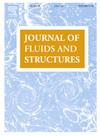Compound-channel-driven shear layer impinging upon streamwise-oriented plates of different solidities
IF 3.5
2区 工程技术
Q1 ENGINEERING, MECHANICAL
引用次数: 0
Abstract
The impingement of a compound open-channel flow upon vertical and streamwise-oriented plates of different solidities located at the edge between main channel and floodplain are investigated experimentally. The plates model finite-length thin hedges along the river bank. The incident flow is characterised by a turbulent shear layer dominated by Kelvin–Helmholtz structures of length . The solidity of the plates is varied from 17% (i.e. 83% porosity) to 100% (solid plate) in order to represent different vegetation densities, while the plate length is fixed to . The velocity field at the free-surface is measured by means of Large-Scale Particle Image Velocimetry (LS-PIV) with a field of view of length and covering the channel width. While the solid plate is shown to induce a significant decrease in the incoming turbulent shear stress, the porous plates instead lead to an overshoot in the turbulent shear stress. All plates induce a reduction of the lateral turbulence intensity, while the longitudinal turbulence intensity is never reduced and even strongly overshoots the incident value for the porous plates. The individual Kelvin–Helmholtz structures are altered when passing the plates but are not destroyed. The alteration of the structures increases with the plates’ solidity, but the vortex cores as well as their spatial periodicity are always maintained, and the structures reform to their original state within a relatively short distance downstream of the plates of about . While for the solid plate the vorticity within the vortex cores decreases by the passage of the plate, in the case of the porous plates the vorticity increases. Vorticity shed from the holes of the porous plates is surmised to be the cause of this increase. The ensemble-averaged Kelvin–Helmholtz structure downstream of each plate reveals that for the least solid plates, the upstream ejection associated with the vortex core is strongly strengthened, which accounts for the observed overshoots in the turbulent stresses. When the plate’s solidity is higher than 67% however, the Kelvin–Helmholtz vortex downstream of the plate has shrunk and weakened, but is accompanied by secondary vortices, generated by the interaction with the plates.
复合通道驱动的剪切层撞击不同凝固程度的顺流取向板
实验研究了复合明渠水流对位于主河道与漫滩边缘的不同凝固程度的垂直板和顺流板的冲击。这些板模拟了沿河岸的有限长度的薄树篱。入射流的特征是一个以长度为l的开尔文-亥姆霍兹结构为主的湍流剪切层。为了代表不同的植被密度,板的固体度从17%(即孔隙率83%)到100%(固体板)不等,板长固定为0.56 l。采用大尺度粒子图像测速仪(LS-PIV)测量了自由表面的速度场,视场长度为3Ls,覆盖了通道宽度。而实心板显示出诱导在传入湍流剪切应力显著降低,多孔板反而导致湍流剪切应力的超调。所有多孔板的横向湍流强度都有所降低,而纵向湍流强度从未降低,甚至大大超过了多孔板的入射值。单个的开尔文-亥姆霍兹结构在通过极板时会发生改变,但不会被破坏。随着板块固体度的增加,结构的变化也随之增加,但旋涡核及其空间周期性始终保持不变,在板块下游约1.5 l的较短距离内,结构恢复到原来的状态。对于实心板,涡核内涡量随着板的通过而减小,而对于多孔板,涡核内涡量增大。从多孔板的孔洞流出的涡量被推测是这种增加的原因。每个板块下游的整体平均开尔文-亥姆霍兹结构表明,对于固体最少的板块,与涡旋核心相关的上游喷射被强烈加强,这解释了观察到的湍流应力的超调。而当板块的固体度大于67%时,板块下游的Kelvin-Helmholtz涡收缩减弱,但伴随着与板块相互作用产生的二次涡。
本文章由计算机程序翻译,如有差异,请以英文原文为准。
求助全文
约1分钟内获得全文
求助全文
来源期刊

Journal of Fluids and Structures
工程技术-工程:机械
CiteScore
6.90
自引率
8.30%
发文量
173
审稿时长
65 days
期刊介绍:
The Journal of Fluids and Structures serves as a focal point and a forum for the exchange of ideas, for the many kinds of specialists and practitioners concerned with fluid–structure interactions and the dynamics of systems related thereto, in any field. One of its aims is to foster the cross–fertilization of ideas, methods and techniques in the various disciplines involved.
The journal publishes papers that present original and significant contributions on all aspects of the mechanical interactions between fluids and solids, regardless of scale.
 求助内容:
求助内容: 应助结果提醒方式:
应助结果提醒方式:


